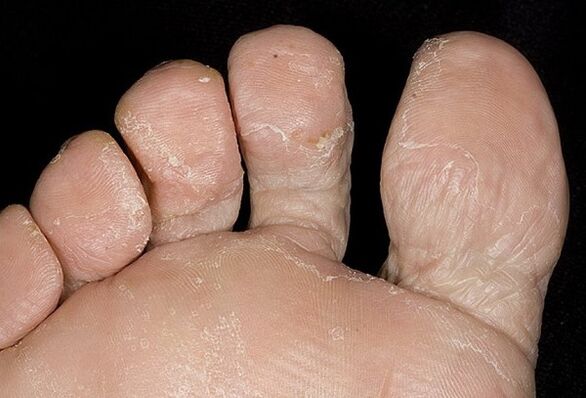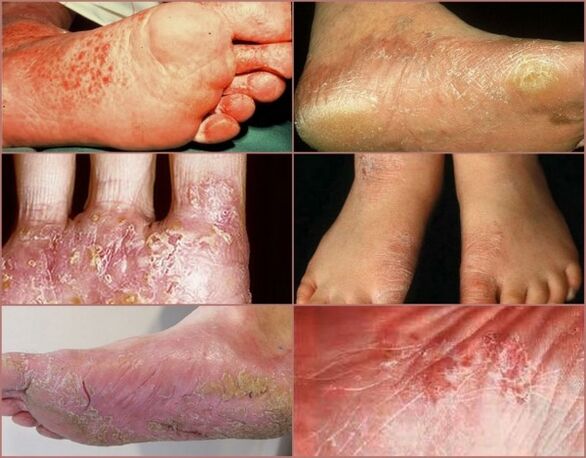The skin fungus on the legs in the photo and in life looks ugly.It not only creates many problems with appearance, unpleasant smell and constant symptoms, but can also cause severe fungal infections that spread far beyond the foot.
What does mushroom look like on the legs, fingers and nails in the photo
The appearance of the mushroom is diverse - it depends on the type of pathogen, the skin properties, the limits of the disease, the diseases under which the patient lives, the characteristics of his hygiene regime.The main localization areas of the lesion are nails, wrinkles between the fingers and the sole.
The affected nails (onychomycosis) usually have an untidy, appearing, uneven edge, an increased fragility that crumbles.The nails often become convex, but this also happens unevenly.
Intermonded folds are an area in which high humidity is almost constantly preserved.They are affected by people who wear uncomfortable or non -appropriate weather shoes.With constant sweat secretion, the reproduction of mushrooms is activated and red spots appear that is reminiscent of apps, yellowish crusts and blood wounds with a white attack.
The lesion of the sole is characterized by peeling the skin over the entire surface, the coincidence and layer.At the same time, inconvenience can occur when walking, increased sweating, which stimulates the growth of the mushroom even more.
Types of mushrooms of the legs

Mycoses (fungal diseases) of the legs are shown because they are caused by various pathogens.Depending on the type of fungus and the characteristics of the patient's skin, different diseases are differentiated.
Rubrophytia means Tr. Mental- An extremely contagious mushroom lives in damp rooms (public baths, pools).A characteristic feature is the peeling and reddening of the skin, swelling of the legs, itching and combs, bleeding occurs easily when they are damaged.
Candidiasis is an infection with a mushroom of the genus Candida, the most common pathogenic mushroom.The defeat of the interdigital folds and soles is characteristic.There is severe itching, pain and peeling the skin.Under the peeling scales you can see erosion with a white attack.
Onychomycosis is the damage to the nails that can have different weights.The skin lesion, less deep than rubrytius, is referred to as epidermophytia.It is characterized by an unexplained swelling, but by noticeable peeling the skin.
Development levels
Regardless of the type of pathogen, the fungus takes place in several phases in its development:
| The initial phase | The pathology is similar to the layered legs - itching, dryness and peeling of the skin, small cracks appear, swelling are possible. |
| The middle stage | Active exfoliation of large layers of skin, the appearance of spots of different shadows, severe swelling, itching and maceration (combs) on the skin. |
| Heavy stage | Deep cracks from which blood can be released, plenty of skin peeling, the occurrence of deep skin defects and herd of secondary infection. |
Failure lesions run according to a similar scheme - first the edge of the nail plate is affected, then gray paths appear over the entire nail, the nail becomes thicker, becomes brittle, changes the color (yellow, white or black).
Symptoms of fungal diseases of the legs
The most striking symptom for the mushroom damage to the foot is a serious itching.In the early stages of the disease, it is only available when walking or finding in unpleasant, "incomplete" shoes in which sweating is stimulated.Then it becomes constant and very strong.Water or bim process can alleviate the condition, but its effect is only temporary.
The second bright symptom is the peeling of the skin.It is expressed, sometimes catastrophic parts reached when large layers of skin are peeled.In nature, however, it can be less pronounced - the constant peeling of scales that captures an increasing area of the foot.
Change the shape of the nails with onychomycosis - nails become thick and brittle.The layer under the nails (hyperkeratosis) crumbles when the nails are cut.In some cases it is possible to solve the nail in the nail bed in difficult situations - loss.A new nail in its place grows with hyperkeratosis and "paths", irregular shape.
The initial phase
The skin fungus on the legs, the photo of which can later be seen, is differentiated by gradual development.Therefore, the disease cannot manifest itself in the early stages.The first signs are at a long time, the skin, the appearance of peeling scales on the soles.Nail fungus no longer manifests itself than a skin fungus.
Some signs with which you can assume the fungus:
- The skin condition deteriorated after the pool, the sauna, the gym or another place with high humidity and a large number of visitors.
- Itching increases in a damp environment;
- The pigmentation of the skin has changed - stains appeared;
- The peeling occurs unevenly along the entire foot and focuses more on the area between the fingers and on the sole.
- Similar symptoms are observed at the same time in several people who jointly visited places of possible infection or live in the same apartment.
Interdalz form
This shape is most unpleasant for the patient.The main localization of the lesions is the wrinkles between the fingers, mostly 3 and 4 of the finger suffer less - the fold between 1 and 2. This is connected to the characteristics of the structure of the sole.For the fungus, the conditions for high temperature and humidity are ideal, while the minimum exposure to air or mechanical factors that can eliminate the fungus.
There are conditions that are generated in the fold between 3 and 3 fingers - the least mobile of all.
Characteristic symptoms - itching and burn at the place of the lesion, the appearance on the skin of lesions that are similar with the progression of the disease are inflammatory ulcers that are covered with white coating.Touching is extremely painful.
How the squamous hyperkeratotic stage is manifested
This phase is characteristic of diseases that affect the sole.The most lively symptoms are expressed skin scarves, its excessive keratization.The soles look rude, the sensitivity of the skin decreases and touches them uncomfortably.The scales are spiced up by large layers, or vice versa their separation occurs into difficulties while the skin is possible.
The feet affected by the mushroom make it easier.Going is uncomfortable - during a long -term stay in shoes, itching and pain in the legs reinforce.

Dyshidrotic stage
It is characterized by a change in sweating.None of the types of mushrooms can settle in the sweat gland, but indirectly, which influences the epidermis, the inflammation process disturbs sweating.
The peculiarity of this form is the formation of large bubbles on the skin, which melt out slightly.In most cases, the disease begins with an Inter -Backball form and gains a difficult course as progress.
The second characteristic feature is plenty of sweating and unpleasant smell of legs.On the soles there are apocrine (differing thick sweat) sweat glands, this explains the sharp than in open areas, even in healthy people.Due to the mushroom, sweating increases, so the smell increases.
Diagnosis of the mushrooms of the legs
The skin fungus on the legs, the photo of which is given below, has characteristic external manifestations, so that the dermatologist begins the diagnostic process by examining the affected limb.This procedure should only be carried out in gloves, since there is a great risk for the doctor that the patient will be infected.
The information obtained during the inspection illustrates the history of the anamnesis - a visit to places where the mushroom that bears the shoes of another or lives in the same apartment with a sick person.
A microbiological examination is carried out for a more precise diagnosis - a small fragment of the skin, nail or bubbles separated in a sterile container and then under a microscope.Such an analysis takes time, so it is carried out to confirm or adapt the treatment scheme, or in cases where the appearance of the fungus raises doubts.
Effective treatment methods
The main task of the treatment is to eliminate the pathogen.Various products are used for this purpose that are applied to affected skin or absorbed inside.The treatment is mandatory for all family members to rule out re -infection.
For the same purpose, the patient must be used to corresponding to the rules for personal hygiene and caution if they visit public places where they can be infected with a fungus.
In the therapy, the fungus should never use antibiotics - these drugs cause the death of bacteria and free the living space for fungi, which increases the patient's condition.However, a good effect is given by products that increase immunity because the fungus is part of a normal skin microflora.
Pharmaceuticals Good and inexpensive ointment
The skin fungus on the legs is treated comprehensively.The main thing is to eliminate the pathogen.
For this purpose, antifungals are used - they are applied directly to the skin and influence the affected area of the foot.In addition, they do not cause systemic side effects, i.e.H. not to be included in the blood.
After washing the legs, the ointment is applied to the skin from 3 to 8 per day, depending on the intensity of the process and the type of ointment.The tool does not have to be washed off, but it should absorb (5-10 minutes) before putting on socks and shoes.
There is medical paint to fight the mushroom of nails.They are colorless and have no smell.The paint covers the nails with a layer of a medical substance that is not held for one day, is not washed off with water, is not washed and does not have to be updated during the day.This enables people who have a close work plan or those who are sick on vacation.
To improve the effect of antifungal
Preparations for internal use
The use of medicinal products for oral administration is displayed in cases in which the disease is a serious course, extensive distribution or the patient is able to treat the legs with antifungals with sufficient frequency.Medicines can also be prescribed to strengthen immunity.
The skin fungus on the legs, which is further presented in the photo in the article, is treated with antifungal.They are used in combination with ointments or as an independent tool.The doctor decides which tool is shown in this case.
With the development of complications of the mushroom, hospital stays and the introduction of the same medication may be required intravenously.
In complex therapy, anti -inflammatory tablets, medication to increase immunity and other medications can be prescribed at the discretion of the specialist.The aim of their purpose is to increase the resistance of the body against pathogenic influences and to improve the effectiveness of antifungal treatment.
People's funds against the mushroom
People's funds for the fight against fungus are also based on an anti -inflammatory and disinfectant effect.For the most part, these are foot baths based on different healing fees.Their effectiveness is lower than the pharmacy medication, but enables you to improve the patient's health.Before use, it is advisable to consult a doctor so as not to reduce the general effectiveness of the treatment.

The skin fungus on the legs (the photo below shows how unattractive the problem looks, if not treated), is successfully eliminated by bathrooms with Celandine or Calendula.For this purpose, plants are raw materials in boiling water, the resulting mixture is filtered and dissolved in warm water.The temperature of the bath should be so that the patient is comfortable to lower his legs in it.
As an additional components, you can add chamomile, burdock, cooking bananas and wormwood.
There are also recommendations for the washing powder (popular) as the main therapy component of the bathroom, the affected areas with BF glue and iodine or vinegar.It should be remembered that referendums require caution in circulation so that health is not harmful.
prevention
To avoid infection with a mushroom, several simple rules should be observed:
- Watch the rules of personal hygiene - the legs should be clean and dry.You have to use the cream for dry skin.
- If you wear comfortable socks and shoes that correspond to the weather, choose "breathing materials" that cause comfortable conditions for the skin.
- If you visit pools, public baths and other places where you can infect yourself with a mushroom, use slippers for the pool and after returning home to wash your legs.
- Use only your hygienic accessories - towels, pedicure harvests;
- When the fungus is determined, the whole family must be treated, regardless of whether the symptoms have appeared.
A good result gives hardening and other processes that strengthen the immune system.This prevents the development of a fungal infection during the infection.It is important to monitor nutrition - the preservation of a sufficient amount of proteins and vitamins supports immunity, and the excess of sweets can stimulate the growth of fungi.
Photos of the skin mushroom on the legs look repulsive, but this disease can be curable with the correct approach.It can be healed pretty quickly (within 1-2 weeks).If no complications have developed, the patient can go through a treatment course without interrupting and resting the work.Hospital stay is only necessary in patients with immunity disorders in the most severe and most advanced cases.


















